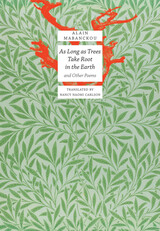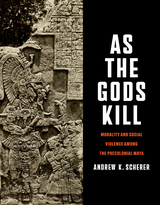5 books about Chase, Mark W.
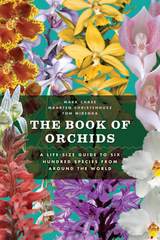
The Book of Orchids
A Life-Size Guide to Six Hundred Species from around the World
Mark W. Chase, Maarten J. M. Christenhusz, and Tom Mirenda
University of Chicago Press, 2017
One in every seven flowering plants on earth is an orchid. Yet orchids retain an air of exotic mystery—and they remain remarkably misunderstood and underappreciated. The orchid family contains an astonishing array of colors, forms, and smells that captivate growers from all walks of life across the globe. Though undeniably elegant, the popular moth orchid—a grocery store standard—is a bland stand-in when compared with its thousands of more complex and fascinating brethren, such as the Demon Queller, which grows in dark forests where its lovely blooms are believed to chase evil forces away. There is the Fetid Sun-God, an orchid that lures female flies to lay their eggs on its flowers by emitting a scent of rancid cheese. Or the rare, delicate Lizard Orchid, which mimics the appearance of lizards but smells distinctly of goat.
The Book of Orchids revels in the diversity and oddity of these beguiling plants. Six hundred of the world’s most intriguing orchids are displayed, along with life-size photographs that capture botanical detail, as well as information about distribution, peak flowering period, and each species’ unique attributes, both natural and cultural. With over 28,000 known species—and more being discovered each year—the orchid family is arguably the largest and most geographically widespread of the flowering plant families. Including the most up-to-date science and accessibly written by botanists Mark Chase, Maarten Christenhusz, and Tom Mirenda, each entry in The Book of Orchids will entice researchers and orchid enthusiasts alike.
With stunning full-color images, The Book of Orchids is sure to become the go-to reference for these complex, alluring, and extraordinarily adaptable plants.
The Book of Orchids revels in the diversity and oddity of these beguiling plants. Six hundred of the world’s most intriguing orchids are displayed, along with life-size photographs that capture botanical detail, as well as information about distribution, peak flowering period, and each species’ unique attributes, both natural and cultural. With over 28,000 known species—and more being discovered each year—the orchid family is arguably the largest and most geographically widespread of the flowering plant families. Including the most up-to-date science and accessibly written by botanists Mark Chase, Maarten Christenhusz, and Tom Mirenda, each entry in The Book of Orchids will entice researchers and orchid enthusiasts alike.
With stunning full-color images, The Book of Orchids is sure to become the go-to reference for these complex, alluring, and extraordinarily adaptable plants.
[more]
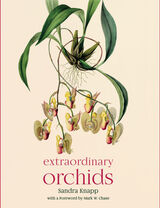
Extraordinary Orchids
Sandra Knapp
University of Chicago Press, 2021
Perching on tropical trees, partnering with fungi to reproduce, or deceiving birds and amorous insects to promote pollination, orchids fascinate. In the exquisitely illustrated Extraordinary Orchids, award-winning botanist and writer Sandra Knapp tells the stories behind some of the bizarre lifestyles and interactions that scientists have uncovered among many species of the orchid family.
Orchids deserve such a visual celebration: parts of the orchid flower have shapes unlike any other flowering plant, and the sheer number of species means they have a seemingly endless ability to create ever more fantastical forms. In fact, many orchid common names refer to the shape-shifting forms of their flowers—the “man-orchids” or “monkey-orchids” are so called because of their resemblance to the primate form. Orchids lend themselves to depiction, and botanical artworks of them abound. Who could resist painting or drawing such odd shapes?
Illustrated with stunning artwork, much from the archives of the Natural History Museum in London and never before published, Extraordinary Orchids includes depictions from celebrated botanical artists such as Ferdinand and Franz Bauer, Arthur Harry Church, and Sydney Parkinson, revealing the weird and wonderful lives of this most diverse of plant families.
Orchids deserve such a visual celebration: parts of the orchid flower have shapes unlike any other flowering plant, and the sheer number of species means they have a seemingly endless ability to create ever more fantastical forms. In fact, many orchid common names refer to the shape-shifting forms of their flowers—the “man-orchids” or “monkey-orchids” are so called because of their resemblance to the primate form. Orchids lend themselves to depiction, and botanical artworks of them abound. Who could resist painting or drawing such odd shapes?
Illustrated with stunning artwork, much from the archives of the Natural History Museum in London and never before published, Extraordinary Orchids includes depictions from celebrated botanical artists such as Ferdinand and Franz Bauer, Arthur Harry Church, and Sydney Parkinson, revealing the weird and wonderful lives of this most diverse of plant families.
[more]
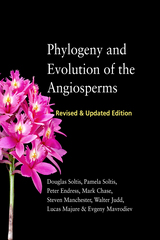
Phylogeny and Evolution of the Angiosperms
Revised and Updated Edition
Douglas Soltis, Pamela Soltis, Peter Endress, Mark Chase, Steven Manchester, Walter Judd, Lucas Majure, and Evgeny Mavrodiev
University of Chicago Press, 2018
Although they are relative latecomers on the evolutionary scene, having emerged only 135‒170 million years ago, angiosperms—or flowering plants—are the most diverse and species-rich group of seed-producing land plants, comprising more than 15,000 genera and over 350,000 species. Not only are they a model group for studying the patterns and processes of evolutionary diversification, they also play major roles in our economy, diet, and courtship rituals, producing our fruits, legumes, and grains, not to mention the flowers in our Valentine’s bouquets. They are also crucial ecologically, dominating most terrestrial and some aquatic landscapes.
This fully revised edition of Phylogeny and Evolution of the Angiosperms provides an up-to-date, comprehensive overview of the evolution of and relationships among these vital plants. Incorporating molecular phylogenetics with morphological, chemical, developmental, and paleobotanical data, as well as presenting a more detailed account of early angiosperm fossils and important fossil information for each evolutionary branch of the angiosperms, the new edition integrates fossil evidence into a robust phylogenetic framework. Featuring a wealth of new color images, this highly synthetic work further reevaluates long-held evolutionary hypotheses related to flowering plants and will be an essential reference for botanists, plant systematists, and evolutionary biologists alike.
This fully revised edition of Phylogeny and Evolution of the Angiosperms provides an up-to-date, comprehensive overview of the evolution of and relationships among these vital plants. Incorporating molecular phylogenetics with morphological, chemical, developmental, and paleobotanical data, as well as presenting a more detailed account of early angiosperm fossils and important fossil information for each evolutionary branch of the angiosperms, the new edition integrates fossil evidence into a robust phylogenetic framework. Featuring a wealth of new color images, this highly synthetic work further reevaluates long-held evolutionary hypotheses related to flowering plants and will be an essential reference for botanists, plant systematists, and evolutionary biologists alike.
[more]
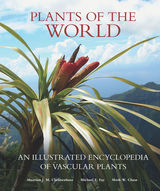
Plants of the World
Maarten J. M. Christenhusz, Michael F. Fay, and Mark W. Chase
Royal Botanic Gardens, Kew, 2017
Plants of the World is the first book to systematically explore every vascular plant family on earth—more than four hundred and fifty of them—organized in a modern phylogenetic order. Detailed entries for each family include descriptions, distribution, evolutionary relationships, and fascinating information on economic uses of plants and etymology of their names. All entries are also copiously illustrated in full color with more than 2,500 stunning photographs. A collaboration among three celebrated botanists at the Royal Botanic Gardens, Kew, Plants of the World is authoritative, comprehensive, and beautiful. Covering everything from ferns to angiosperms, it will be an essential resource for practicing botanists, horticulturists, and nascent green thumbs alike.
[more]
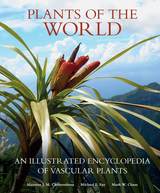
Plants of the World
An Illustrated Encyclopedia of Vascular Plants
Maarten J. M. Christenhusz, Michael F. Fay, and Mark W. Chase
University of Chicago Press, 2017
Plants of the World is the first book to systematically explore every vascular plant family on earth—more than four hundred and fifty of them—organized in a modern phylogenetic order. Detailed entries for each family include descriptions, distribution, evolutionary relationships, and fascinating information on economic uses of plants and etymology of their names. All entries are also copiously illustrated in full color with more than 2,500 stunning photographs. A collaboration among three celebrated botanists at the Royal Botanic Gardens, Kew, Plants of the World is authoritative, comprehensive, and beautiful. Covering everything from ferns to angiosperms, it will be an essential resource for practicing botanists, horticulturists, and nascent green thumbs alike.
[more]
READERS
Browse our collection.
PUBLISHERS
See BiblioVault's publisher services.
STUDENT SERVICES
Files for college accessibility offices.
UChicago Accessibility Resources
home | accessibility | search | about | contact us
BiblioVault ® 2001 - 2025
The University of Chicago Press



